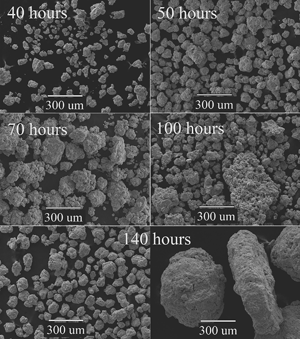Article contents
High-Energy Ball Milling Conditions in Formation of NiTiCu Shape Memory Alloys
Published online by Cambridge University Press: 10 September 2021
Abstract

The properties and the shape memory effect depend, among other things, on chemical composition, as well as the method of shape memory alloy (SMA) production. One of the manufacturing methods that leads to the amorphous/nanocrystalline SMA is high-energy ball milling combined with annealing. Using this technique, an SMA memory alloy, with the nominal chemical composition of Ni25Ti50Cu25, was produced from commercial elemental powders (purity −99.7%). The structure and morphology were characterized (at the various stages of its production) by the use of X-ray diffraction, as well as electron microscopy (both scanning and transmission). Choosing the appropriate grinding time made it possible to produce an NiTiCu alloy with a different crystallite size. Its average size changed from 6.5 nm (after 50 h) to about 2 nm (100 h). Increasing the grinding time up to 140 h resulted in the formation of areas that showed the B19 martensite and the Ti2(Ni,Cu) phase with the average crystallite size of about 6 nm (as milled). After crystallization, the average size increased to 11 nm.
Keywords
- Type
- The XVIIth International Conference on Electron Microscopy (EM2020)
- Information
- Copyright
- Copyright © The Author(s), 2021. Published by Cambridge University Press on behalf of the Microscopy Society of America
References
- 2
- Cited by




